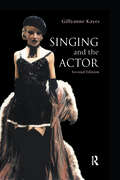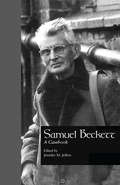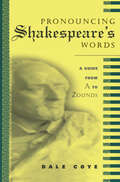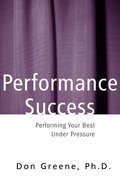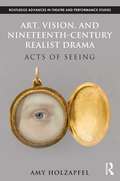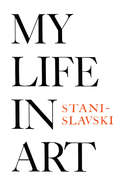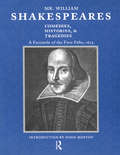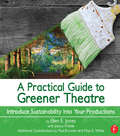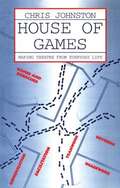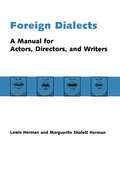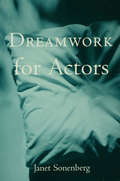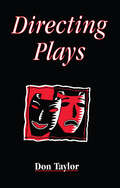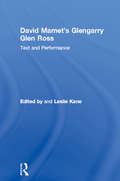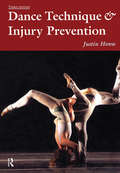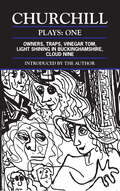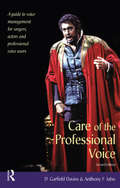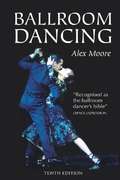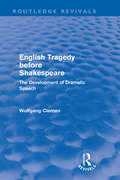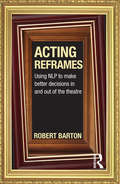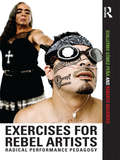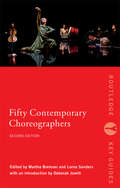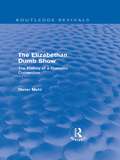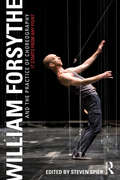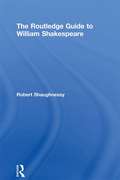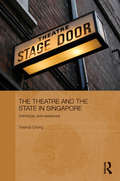- Table View
- List View
Singing and the Actor (Ballet, Dance, Opera And Music Ser.)
by Gillyanne KayesSinging and the Actor takes the reader step by step through a practical training programme relevant to the modern singing actor and dancer. A variety of contemporary voice qualities including Belting and Twang are explained, with excercises for each topic.
Samuel Beckett: A Casebook (Casebooks On Modern Dramatists Ser. #25)
by Jennifer M. JeffersFirst published in 1998. Routledge is an imprint of Taylor & Francis, an informa company.
Pronouncing Shakespeare's Words: A Guide From A To Zounds
by Dale CoyeFirst published in 2003. Routledge is an imprint of Taylor & Francis, an informa company.
Performance Success: Performing Your Best Under Pressure
by Don GreenePerformance Success teaches a set of skills so that a musician can be ready to go out and sing or play at his or her highest level, working with energies that might otherwise be wasted in unproductive ways. This is a book of skills and exercises, prepared by a master teacher.
Art, Vision, and Nineteenth-Century Realist Drama: Acts of Seeing (Routledge Advances in Theatre & Performance Studies)
by Amy HolzapfelRealism in theatre is traditionally defined as a mere seed of modernism, a crude attempt to reproduce an exact copy of reality on stage. Art, Vision & Nineteenth-Century Realist Drama redefines realism as a complex and under-examined form of visual modernism, one that positioned theatre at the crux of the encounter between consciousness and the visible world. Tracing a historical continuum of "acts of seeing" on the realist stage, Holzapfel demonstrates how theatre participated in modernity’s aggressive interrogation of vision’s residence in the human body. New findings by scientists and philosophers—such as Diderot, Goethe, Müller, Helmholtz, and Galton—exposed how the visible world is experienced and framed by the unstable relativism of the physiological body rather than the fixed idealism of the mind. Realist artists across media paradoxically embraced this paradigm shift by focusing on the embodied observer. Drawing from extensive archival research, Holzapfel conducts close readings of iconic dramas and their productions—including Scribe’s The Glass of Water, Zola’s Thérèse Raquin, Ibsen’s A Doll House, Strindberg’s The Father, and Hauptmann’s Before Sunrise—alongside analyses of artwork by major painters and photographers—such as Chardin, Nadar, Millais, Rejlander, and Liebermann. In a radical challenge to existing criticism, Holzapfel argues that realism in theatre was never the attempt to reproduce an exact copy of the seen world but rather the struggle to make visible the act of seeing.
My Life in Art (Bloomsbury Revelations Ser.)
by Constantin StanislavskiFirst published in 1987. Routledge is an imprint of Taylor & Francis, an informa company.
Mr. William Shakespeares Comedies, Histories, and Tragedies: A Facsimile of the First Folio, 1623
by Doug MostonFor the first time, a photographic facsimile of the First Folio of Shakespeare's plays is available in one affordable volume. Mr. William Shakespeares Comedies, Histories, and Tragedies gives actors, directors, and anyone interested in Shakespeare access to the plays as Shakespeare envisioned them. In returning to the original text, actors and directors can find answers to the many problems they find preparing a play of Shakespeare. Included is the introduction to acting from the First Folio and its accompanying acting guide and glossary, making this the most valuable tool for all who love the Bard.
A Practical Guide to Greener Theatre: Introduce Sustainability Into Your Productions
by Ellen E. JonesProtecting the environment should be a priority of every theatrical production, but it can be challenging to mount an environmentally-friendly show with limited time, resources, and information. A Practical Guide to Greener Theatre: Introduce Sustainability Into Your Productions not only gives you the information you need to make greener decisions, but provides you with practical, workable solutions. You will learn how to assess and improve every production area – from costuming and painting, lighting and technical direction, to administrative offices and the rehearsal process. Checklists, examples of successful strategies, and step-by-step instructions will show you how to identify areas where manageable, sustainable changes can make your productions greener, and advice from working professionals, with experience greening their own productions, will leave you confident that your processes are environmentally sound. Even non-technical people who find themselves responsible for supervising productions will find green solutions that can be instituted with a staff of volunteers or students. Remember: every step toward sustainability is a step forward. Discover small fixes that will make your theatre productions greener. Examine ways to introduce greener practices in the design, execution, and strike process. Explore how introducing sustainability into your theatre productions can save your company time and money. Learn how sustainability and safety intersect to help protect your workers and volunteers.
House of Games
by Chris JohnstonAn immensely valuable resource book for drama leaders, House of Games is a how-to book for building up drama troupes and keeping them creative. House of Games is sure to take its place alongside the most established drama method texts.
Foreign Dialects: A Manual for Actors, Directors, and Writers
by Lewis Herman Marquerite Shalett HermanMost actors and directors have struggled with the problem of needing to imitate foreign dialects. Marguerite and Lewis Herman have created an essential tool for actors, directors and writers aiming toward the most authentic performances possible.Foreign Dialects contains an extensive repertoire of dialects that will assist the actor in the preparation for the most difficult foreign roles. Now in paperback, this classic text offers the director or producer a quick, convenient aid for correcting actors and evaluating applicants for authenticity and dialect ability. In addition, it guides those writing fiction as well as radio, movie, and television scripts. Thirty foreign dialects are provided, with character studies, speech peculiarities, and examples of the dialects in easy-to-read phonetic monologues--including Cockney, British, Irish, Scottish, French, German, Spanish, Swedish, Polish, Greek and Yiddish.
Dreamwork for Actors
by Janet SonenbergDrawing upon her wide experience as actor and director, Janet Sonenberg shows what dreamwork can do. No other acting technique offers the performer's own dreams as a means to profoundly deepen imaginative and artistic expression. This is a wholly new tool with which actors can unleash startling performances.
Directing Plays (Stage And Costume Ser.)
by Don TaylorDirecting Plays explores both the theory and practice of directing plays, with particular emphasis on textual interpretation. Don Taylor guides the student through the complex process of choosing a play, the working partnership of director, playwright and designer, the delicate matter of casting a play, the rehearsal process and everything which needs to happen before the production is up and running.
David Mamet's Glengarry Glen Ross: Text and Performance (Studies In Modern Drama Ser. #Vol. 8)
by Leslie KaneFirst published in 1997. Routledge is an imprint of Taylor & Francis, an informa company.
Dance Technique and Injury Prevention (Ballet, Dance, Opera And Music Ser.)
by Justin Howse Shirley HancockDance Technique and Injury Prevention has established itself as the key reference for everyone involved in dance injury and treatment, physical therapy, and dance instruction.
Churchill: Plays One
by Caryl ChurchillThe plays in this volume represent the best of Churchill's writing up to and including her emergence onto the international theatre scene with "Cloud Nine." The volume also contains a new introduction by the author as well as short prefaces to each play.
Care of the Professional Voice: A Guide to Voice Management for Singers, Actors and Professional Voice Users
by D Garfield Davies Anthony F JahnSinger and actors are a unique group of performers, relying almost entirely on their voice for the professional livelihood. Jet lag, amplification, allergens, stress, pollution, and vocal strain all affect vocal performance. Written for the performer, the teacher, and the vocal coach, Care of the Professional Voice offers clear explanations and medical advice on vocal problems and vocal health. Care of the Professional Voice is written by experts in laryngology in the United States and Great Britain. This second edition includes a singer's guide to self-diagnosis.
Ballroom Dancing (Performing Arts Ser.)
by Alex MooreNow in its tenth edition, this classic and comprehensive handbook has been revised to bring it up to date in keeping with changes on the dance floor and in the rules of dance competitions. The Quickstep, Waltz, Foxtrot, and Tango are all illustrated and described in great detail.
English Tragedy before Shakespeare: The Development of Dramatic Speech (Routledge Revivals)
by Wolfgang ClemenFirst published in English in 1961, this reissue relates the problems of form and style to the development of dramatic speech in pre-Shakespearean tragedy. The work offers positive standards by which to assess the development of pre-Shakespearean drama and, by tracing certain characteristics in Elizabethan tragedy which were to have a bearing on Shakespeare’s dramatic technique, helps to illuminate the foundations on which Shakespeare built his dramatic oeuvre.
Acting Reframes: Using NLP to Make Better Decisions In and Out of the Theatre
by Robert BartonActing Reframes presents theatre and film practitioners with a methodology for using Neuro-Linguistic Programming (NLP) as a tool to aid their practice. Author Robert Barton uses the NLP approach to illustrate a range of innovative methods to help actors and directors, including: • reducing performance anxiety • enabling clearer communication • intensifying character analysis • stimulating imaginative rehearsal choices. The author also shows how NLP can used alongside other basic training systems to improve approaches to rehearsal and performance. The book shows the use of NLP to the reader in a playful, creative and easily accessible style that is structured to enable solo study as well as group work. The text offers a range of engaging exercises and extensive analysis of language patterns used in performance. It is a source for enhancing communication between all theatre practitioners in training, productions, and daily life outside the theatre. Acting Reframes gives actors a richly rewarding approach to help them develop all aspects of their craft.
Exercises for Rebel Artists: Radical Performance Pedagogy
by Guillermo Gómez Peña Roberto SifuentesIn Exercises for Rebel Artists, Guillermo Gomez-Pena and Roberto Sifuentes use their extensive teaching and performance experience with La Pocha Nostra to help students and practitioners to create ‘border art’. Designed to take readers right into the heart of radical performance, the authors use a series of crucial practical exercises, honed in workshops worldwide, to help create challenging theatre which transcends the boundaries of nation, gender, and racial identity. The book features: Detailed exercises for using Pocha Nostra methods in workshops Inspirational approaches for anyone creating, producing or teaching radical performance A step-by-step guide for large-scale group performance New, unpublished photos of the Pocha Nostra method in practice Exercises for Rebel Artists advocates teaching as an important form of activism and as an extension of the performance aesthetic. It is an essential text for anyone who wants to learn how use performance to both challenge and change.
Fifty Contemporary Choreographers (Routledge Key Guides)
by Martha Bremser Lorna SandersA unique and authoritative guide to the lives and work of prominent living contemporary choreographers. Representing a wide range of dance genres, each entry locates the individual in the context of modern dance theatre and explores their impact. Those studied include: Jerome Bel Richard Alston Doug Varone William Forsythe Phillippe Decoufle Jawole Willa Jo Zollar Ohad Naharin Itzik Gallili Twyla Tharp Wim Vandekeybus With a new, updated introduction by Deborah Jowitt and further reading and references throughout, this text is an invaluable resource for all students and critics of dance, and all those interested in the fascinating world of choreography.
The Elizabethan Dumb Show: The History of a Dramatic Convention (Routledge Revivals)
by Dieter MehlFirst published in English in 1965, this book discusses the roots and development of the dumb show as a device in Elizabethan drama. The work provides not only a useful manual for those who wish to check the occurrence of dumb shows and the uses to which they are put; it also makes a real contribution to a better understanding of the progress of Elizabethan drama, and sheds new light on some of the lesser known plays of the period.
William Forsythe and the Practice of Choreography: It Starts From Any Point
by Steven SpierWilliam Forsythe’s reinvigoration of classical ballet during his 20-year tenure at the Ballett Frankfurt saw him lauded as one of the greatest choreographers of the postwar era. His current work with The Forsythe Company has gone even further to challenge and investigate fundamental assumptions about choreography itself. William Forsythe and the Practice of Choreography presents a diverse range of critical writings on his work, with illuminating analysis of his practice from an interdisciplinary perspective. The book also contains insightful working testaments from Forsythe’s collaborators, as well as a contribution from the choreographer himself. With essays covering all aspects of Forsythe’s past and current work, readers are provided with an unparalleled view into the creative world of this visionary artist, as well as a comprehensive resource for students, scholars, and practitioners of ballet and contemporary dance today.
The Routledge Guide to William Shakespeare
by Robert ShaughnessyDemystifying and contextualising Shakespeare for the twenty-first century, this book offers both an introduction to the subject for beginners as well as an invaluable resource for more experienced Shakespeareans. In this friendly, structured guide, Robert Shaughnessy: introduces Shakespeare’s life and works in context, providing crucial historical background looks at each of Shakespeare’s plays in turn, considering issues of historical context, contemporary criticism and performance history provides detailed discussion of twentieth-century Shakespearean criticism, exploring the theories, debates and discoveries that shape our understanding of Shakespeare today looks at contemporary performances of Shakespeare on stage and screen provides further critical reading by play outlines detailed chronologies of Shakespeare’s life and works and also of twentieth-century criticism The companion website at www.routledge.com/textbooks/shaughnessy contains student-focused materials and resources, including an interactive timeline and annotated weblinks.
The Theatre and the State in Singapore: Orthodoxy and Resistance (Routledge Contemporary Southeast Asia Series)
by Terence ChongThis book provides a comprehensive examination of the contemporary English-language theatre field in Singapore. It describes Singapore theatre as a politically dynamic field that is often a site for struggle and resistance against state orthodoxy, and how the cultural policies of the ruling People’s Action Party (PAP) have shaped Singapore theatre. The book traces such cultural policies and their impact from the early 1960s, and shows how the PAP used theatre – and arts and culture more widely – as a key part of its nation building programme. Terence Chong argues that this diverse theatre community not only comes into regular conflict with the state, but often collaborates with it - depending on the rewards at stake, not to mention the assortment of intra-communal conflicts as different practitioners and groups vie for the same resources. It goes on to explore how new forms of theatre, especially English-language avant garde theatre, represented resistance to such government cultural control; how the government often exerts its power ‘behind-the-scenes’ to preserve its moral legitimacy; and conversely how middle class theatre practitioners’ resistance to state power is strongly influenced by class and cultural capital. Based on extensive original research including interviews with theatre directors and other theatre professionals, the book provides a wealth of information on theatre in Singapore overall, and not just on theatre-state relations.
